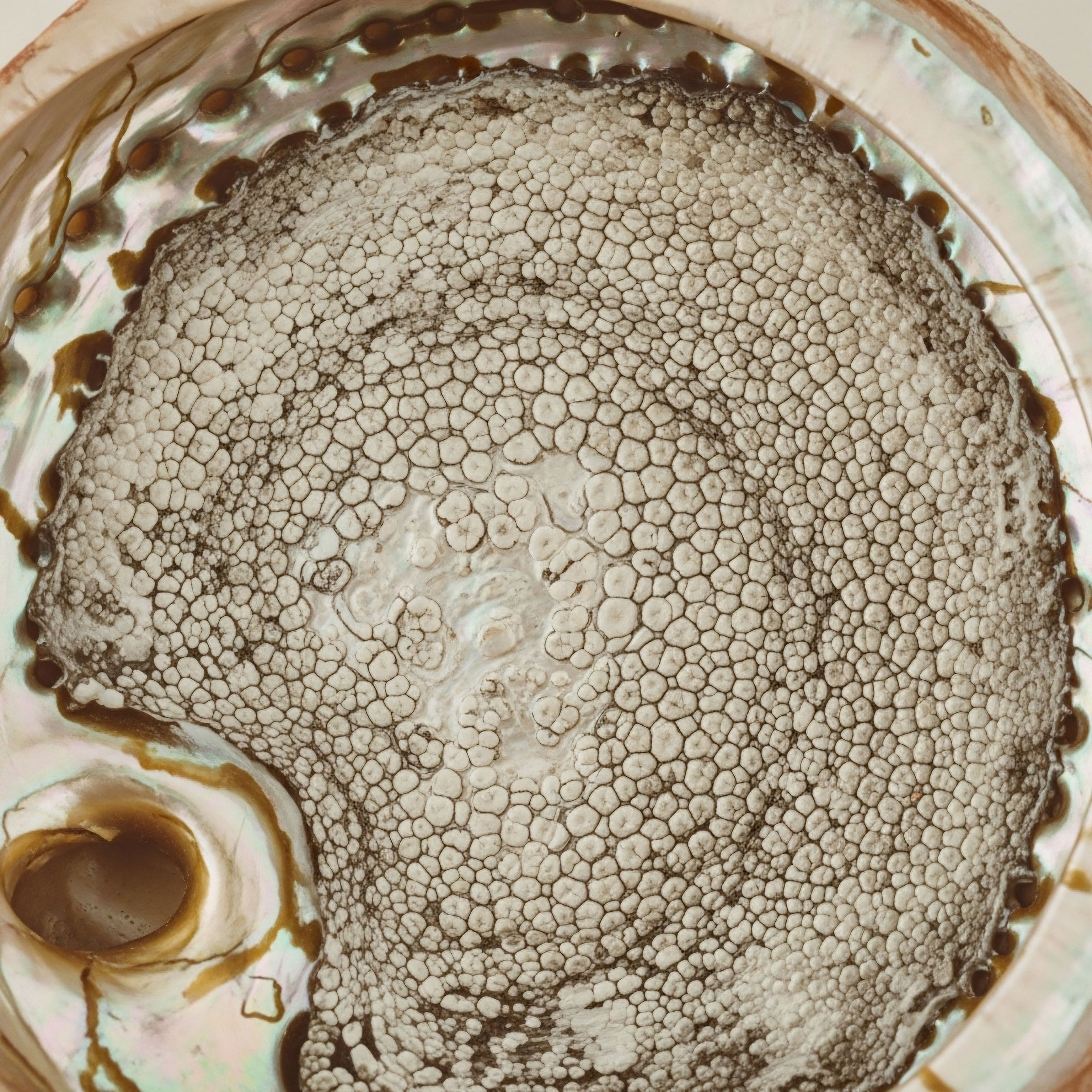

Fundamentals
You may stand in front of the mirror and see a stranger. The person looking back does not reflect the disciplined effort you invest in your diet or the hours committed to the gym. A persistent layer of soft tissue obscures the muscle you have worked to build, while a pervasive fatigue seems to seep into every aspect of your day.
This experience, this disconnect between your actions and your body’s response, is a deeply personal and often frustrating reality. Your body is speaking a language, and the translation is found within the complex, silent world of your endocrine system. The conversation about body composition begins here, with the chemical messengers that dictate where every calorie goes and what every cell becomes.
Hormonal health is the foundational operating system for your physical self. Think of your body as a highly sophisticated corporation. Your conscious choices ∞ what you eat, when you move ∞ are the executive decisions.
Hormones, in this analogy, are the entire communications network, the internal messaging service that carries these executive orders to every department, from the energy-burning furnaces within your muscle cells to the fat-storage warehouses around your abdomen. When this communication network is functioning optimally, the orders are received and executed with precision.
When the signals become weak, crossed, or diminished, the entire corporate body begins to function inefficiently. The result is what you see in the mirror and feel in your bones ∞ a system that seems to be working against you.
The shape and function of your body are a direct physical manifestation of your internal hormonal environment.
The aesthetic changes you seek, what is often termed “body sculpting,” are outcomes of specific biological processes. These processes are governed by a select group of powerful hormonal signals. For men and women, the primary architects of body composition are testosterone, growth hormone, and, through its relationship with other hormones, estrogen.
Testosterone is a profoundly anabolic signal; it directly instructs muscle cells to repair and grow larger and stronger. Simultaneously, it sends a clear message to fat cells, particularly the visceral fat deep within the abdomen, to release their stored energy.
Growth hormone works in concert, promoting the breakdown of fat for fuel and supporting the repair of all tissues, including muscle, bone, and connective tissue. The balance of estrogens, in both sexes, plays a vital role in metabolic rate, fat deposition patterns, and overall systemic inflammation.
As we age, the production of these key hormones naturally declines. For men, this gradual reduction in testosterone and growth hormone is often called andropause. For women, the more turbulent fluctuations and eventual decline of estrogen, progesterone, and testosterone define perimenopause and post-menopause.
This is not a personal failing; it is a predictable biological shift. The communication network weakens. The powerful signals that once maintained lean mass and kept visceral fat in check become quieter. The body, receiving a different set of instructions, begins to prioritize fat storage and allows muscle tissue to atrophy.
This is why efforts that once yielded results in your twenties and thirties may now feel futile. The executive decisions are the same, but the internal communication system has changed the way those orders are interpreted.

The Language of the Endocrine System
Understanding your endocrine system is akin to learning the language of your own biology. It is a system of intricate feedback loops, a constant conversation between your brain and your glands. The Hypothalamic-Pituitary-Gonadal (HPG) axis, for example, is the central command line for sex hormone production.
Your hypothalamus, in the brain, releases a signal (Gonadotropin-Releasing Hormone, or GnRH) to your pituitary gland. The pituitary, in turn, releases signals (Luteinizing Hormone, LH, and Follicle-Stimulating Hormone, FSH) to the gonads (testes in men, ovaries in women). The gonads then produce testosterone and estrogen.
These hormones circulate throughout the body, carrying out their functions, and also report back to the brain, telling it to slow down or speed up production. It is a self-regulating circuit, a biological thermostat. When circulating hormone levels fall due to age or other factors, the thermostat’s set point changes, and the entire system down-regulates.
Hormone replacement therapy, in this context, is a clinical intervention designed to restore the volume and clarity of these essential biological communications, allowing the body to once again execute instructions that favor lean mass and metabolic efficiency.
The goal of this exploration is to move past the surface-level question of aesthetics and into a deeper appreciation of biological function. A sculpted physique is the external sign of an internally optimized system.
It signifies that your hormonal signals are effectively directing nutrients toward muscle synthesis, that your metabolism is efficiently burning fat for energy, and that your body is in a state of repair and vitality. This journey is about understanding the root causes of the changes you are experiencing. It is about translating the complex science of endocrinology into empowering knowledge, giving you the ability to understand your own biological narrative and, with expert guidance, begin to rewrite it.


Intermediate
The recognition that your body’s composition is a direct output of your endocrine system’s signaling is the first step. The next is to understand how these signals can be clinically modulated to restore function and, as a result, reshape your physique.
Hormonal optimization protocols are precise, data-driven interventions designed to re-establish the biochemical conversations that govern metabolic health. These are not blunt instruments; they are targeted strategies that account for the interconnectedness of your internal communication network. The objective is to recalibrate the system, allowing it to function with the efficiency it once possessed.

Protocols for Male Endocrine Support
For many men experiencing the symptoms of androgen deficiency ∞ fatigue, cognitive fog, loss of libido, and an unwelcome shift in body composition ∞ Testosterone Replacement Therapy (TRT) is a foundational protocol. The aim is to restore serum testosterone levels to an optimal physiological range, thereby reinstating its powerful systemic signals. A standard, effective protocol involves a carefully calibrated combination of medications that work synergistically.
A typical regimen is constructed around weekly intramuscular or subcutaneous injections of a bioidentical testosterone, such as Testosterone Cypionate. This provides a stable, predictable elevation of serum testosterone, forming the bedrock of the therapy. The effects at the cellular level are direct.
In muscle cells (myocytes), the increased testosterone binds to androgen receptors, triggering a cascade that enhances protein synthesis, the core mechanism of muscle repair and growth. In fat cells (adipocytes), particularly visceral fat, it promotes lipolysis, the breakdown and release of stored fat. Studies have consistently shown that TRT in men with low testosterone leads to a significant increase in lean body mass and a corresponding decrease in fat mass, especially abdominal fat.
A comprehensive TRT protocol restores the primary anabolic signal while strategically managing its downstream metabolic effects.
However, simply administering testosterone is an incomplete strategy. The body’s endocrine system is a web of feedback loops. Introducing external testosterone signals the Hypothalamic-Pituitary-Gonadal (HPG) axis to shut down its own production. To counteract this, a secondary medication like Gonadorelin is often included.
Gonadorelin is a synthetic form of Gonadotropin-Releasing Hormone (GnRH). Its administration mimics the body’s natural signal from the hypothalamus to the pituitary, prompting the pituitary to continue releasing Luteinizing Hormone (LH) and Follicle-Stimulating Hormone (FSH). This preserves natural testicular function, maintains fertility, and prevents testicular atrophy, ensuring the entire HPG axis remains active.
Another critical component addresses the metabolic conversion of testosterone to estrogen via the aromatase enzyme. While some estrogen is vital for male health (supporting bone density, cognitive function, and libido), excess levels can lead to side effects like water retention and gynecomastia, and can counteract some of the desired body composition effects.
Anastrozole, an aromatase inhibitor, is used in small, carefully titrated doses to manage this conversion. It blocks the aromatase enzyme, preventing the overproduction of estrogen and maintaining a healthy testosterone-to-estrogen ratio. The complete protocol is a sophisticated biochemical recalibration, designed to elevate the primary androgenic signal while maintaining balance throughout the entire endocrine system.
| Component | Mechanism of Action | Primary Goal in Body Sculpting |
|---|---|---|
| Testosterone Cypionate | Directly activates androgen receptors in muscle and fat cells. | Increase protein synthesis (muscle growth); promote lipolysis (fat loss). |
| Gonadorelin | Stimulates the pituitary to release LH and FSH. | Maintains natural testosterone production and systemic hormonal balance. |
| Anastrozole | Inhibits the aromatase enzyme, blocking the conversion of testosterone to estrogen. | Prevents estrogen-related side effects and optimizes the androgen-to-estrogen ratio. |
| Enclomiphene | Selectively blocks estrogen receptors at the pituitary, increasing LH and FSH output. | Can be used as an alternative or adjunct to support natural testosterone production. |

How Do Peptides Differ from Direct Hormone Administration?
While TRT restores a primary hormone, peptide therapies represent a more nuanced approach. They do not replace a hormone directly. Instead, they act as highly specific signaling molecules that stimulate the body’s own glands to produce and release hormones in a natural, pulsatile manner. For body sculpting, the most relevant class of peptides are the Growth Hormone Secretagogues (GHS).
Growth Hormone (GH) is a master hormone for tissue repair and metabolism. It promotes lipolysis and stimulates the liver to produce Insulin-Like Growth Factor 1 (IGF-1), which has powerful anabolic effects on muscle tissue. As with testosterone, GH production declines with age. Direct administration of recombinant human growth hormone (rHGH) can be effective but carries risks and can disrupt the sensitive feedback loops of the GH axis. Growth Hormone Secretagogues offer a more biomimetic alternative.
- Ipamorelin This is a Growth Hormone Releasing Peptide (GHRP). It works by mimicking ghrelin, a natural hormone, and binding to its receptor in the pituitary gland. This action selectively stimulates the pituitary’s somatotroph cells to release a pulse of Growth Hormone. Ipamorelin is highly selective, meaning it causes a clean GH pulse with minimal to no effect on other hormones like cortisol or prolactin, which can interfere with body composition goals.
- CJC-1295 This is a Growth Hormone Releasing Hormone (GHRH) analog. It works on a different receptor in the pituitary, signaling the somatotrophs to increase the amount of GH they produce and store. When used in combination with Ipamorelin, the two peptides have a powerful synergistic effect. CJC-1295 increases the amount of GH available, and Ipamorelin triggers its strong, controlled release.
This combination protocol results in elevated levels of both GH and IGF-1, which translates into significant body composition benefits. The increased GH directly accelerates the breakdown of fat, while the subsequent rise in IGF-1 promotes the repair and growth of lean muscle tissue.
This dual-action mechanism makes the combination of Ipamorelin and CJC-1295 a potent tool for individuals seeking to reduce body fat while preserving or increasing metabolically active muscle. It is a strategy that enhances the body’s own natural output, restoring a youthful signaling pattern that is highly conducive to a lean, strong physique.

Hormonal Support for Female Body Composition
The conversation around hormonal support for women has historically centered on estrogen and progesterone replacement for menopausal symptoms. There is a growing body of evidence and clinical understanding of the vital role testosterone plays in female health, vitality, and body composition.
Women produce testosterone in their ovaries and adrenal glands, and it is crucial for maintaining lean muscle mass, bone density, cognitive clarity, and libido. The decline of testosterone during perimenopause and post-menopause contributes significantly to the common experience of muscle loss (sarcopenia) and increased fat deposition, particularly in the midsection.
A carefully managed protocol of low-dose testosterone can be transformative for women. Using the same Testosterone Cypionate as in male protocols, but at a much lower dose (typically 10-20% of a male dose), can restore youthful androgenic signaling.
The benefits mirror those seen in men ∞ enhanced ability to build and maintain lean muscle in response to exercise, improved metabolic rate, and a reduction in fat storage. This is often combined with bioidentical progesterone, which helps balance the system and has its own benefits for sleep and mood.
For some women, long-acting testosterone pellets, implanted subcutaneously, can provide a steady state of the hormone for several months, offering a convenient alternative to weekly injections. As with men, a small dose of Anastrozole may be used if needed to manage the aromatization of testosterone to estrogen, ensuring the hormonal balance remains optimized for well-being and body composition goals.


Academic
A sophisticated appreciation of hormonal optimization for body sculpting requires a descent into the molecular biology of target tissues. The observable, systemic effects of therapies like TRT ∞ increased muscle mass and decreased adiposity ∞ are the macroscopic outcomes of intricate signaling cascades within individual cells.
The primary mechanism of action for testosterone and other androgens is their interaction with the Androgen Receptor (AR), a member of the nuclear receptor superfamily. Understanding how AR signaling differs in a myocyte (muscle cell) versus an adipocyte (fat cell) is fundamental to comprehending how these therapies reshape the human form at the most granular level.

Differential Androgen Receptor Signaling in Myocytes
When testosterone diffuses across the cell membrane of a myocyte, it binds to and activates the AR in the cytoplasm. This hormone-receptor complex then translocates to the cell nucleus. Inside the nucleus, it functions as a ligand-activated transcription factor, binding to specific DNA sequences known as Androgen Response Elements (AREs) in the promoter regions of target genes. This binding event initiates the transcription of genes responsible for the anabolic phenotype of the muscle cell.
The primary outcome is an upregulation of muscle protein synthesis. The AR complex directly increases the transcription of key genes involved in the machinery of protein creation. Furthermore, it enhances the muscle cell’s ability to utilize amino acids for repair and growth. Another critical action is the promotion of satellite cell activation.
Satellite cells are myogenic stem cells that reside on the periphery of muscle fibers. AR activation signals these dormant cells to proliferate and fuse with existing muscle fibers, donating their nuclei and thereby increasing the fiber’s capacity for protein synthesis and hypertrophy. This is a core mechanism through which muscles grow larger and stronger in response to androgen signaling and mechanical stress from exercise.
Recent research also illuminates a metabolic role for myocyte AR signaling. Studies using transgenic animal models have shown that AR activation within muscle cells is sufficient to increase systemic oxidative metabolism. This suggests that androgens do more than just build muscle; they make the muscle itself a more metabolically active, energy-demanding tissue.
The muscle cell increases its mitochondrial density and the activity of enzymes within the electron transport chain, effectively turning up its own metabolic furnace. This contributes to a higher resting metabolic rate and an improved capacity for fat oxidation throughout the body, driven directly from the muscle tissue.

What Is the Direct Molecular Impact on Adipocytes?
The action of androgens on fat cells is equally profound, yet mechanistically distinct. The AR is also expressed in adipocytes, and its activation by testosterone initiates a series of anti-adipogenic effects. One of the most significant pathways involves the inhibition of adipocyte differentiation. Adipose tissue expands through both hypertrophy (existing fat cells getting larger) and hyperplasia (the creation of new fat cells from pre-adipocytes).
Testosterone signaling, via the AR, directly suppresses the lineage commitment of mesenchymal stem cells toward the adipocyte fate. It interferes with the expression of key adipogenic transcription factors, such as Peroxisome Proliferator-Activated Receptor gamma (PPARγ), the master regulator of adipogenesis. By downregulating PPARγ, testosterone effectively prevents pre-adipocytes from maturing into fully functional, lipid-storing adipocytes. This is a powerful mechanism for limiting the expansion of fat depots, particularly visceral adipose tissue, which is highly sensitive to androgenic signals.
Androgen receptor activation orchestrates a dual mandate at the cellular level, promoting anabolic processes in muscle while simultaneously inhibiting adipogenic pathways in fat.
In addition to inhibiting the creation of new fat cells, AR activation also promotes the breakdown of fat in existing adipocytes. It enhances lipolysis by increasing the expression and sensitivity of beta-adrenergic receptors on the adipocyte surface. These are the same receptors that are activated by catecholamines like adrenaline during exercise.
Increased beta-adrenergic signaling leads to the activation of Hormone-Sensitive Lipase (HSL), the key enzyme that hydrolyzes stored triglycerides into free fatty acids, which can then be released into the bloodstream and used for energy by tissues like muscle. Therefore, androgen signaling in fat tissue creates a cellular environment that is resistant to storing fat and primed for releasing it.
| Cell Type | Key Molecular Pathway | Resulting Physiological Effect |
|---|---|---|
| Myocyte (Muscle Cell) | Binds to AREs, increasing transcription of contractile protein genes and activating satellite cells. | Enhanced muscle protein synthesis and hypertrophy (muscle growth). |
| Myocyte (Muscle Cell) | Upregulates mitochondrial biogenesis and enzymes of the electron transport chain. | Increased local and systemic oxidative metabolism. |
| Pre-Adipocyte (Fat Precursor Cell) | Inhibits the expression and activity of the master adipogenic regulator, PPARγ. | Suppression of adipocyte differentiation (fewer new fat cells are created). |
| Adipocyte (Mature Fat Cell) | Increases expression of beta-adrenergic receptors and activity of Hormone-Sensitive Lipase (HSL). | Promotion of lipolysis (breakdown and release of stored fat). |
This dual-pronged molecular strategy explains the potent body recompositioning effects observed with testosterone therapy. It is a coordinated biological program that simultaneously builds a metabolically expensive tissue (muscle) while dismantling and inhibiting the expansion of an energy storage tissue (fat).
This systems-biology perspective reveals that hormonal therapies are not just about restoring a number on a lab report. They are about re-engaging specific, powerful molecular pathways at the cellular level to shift the body’s entire metabolic and structural equilibrium toward a state of greater lean mass and lower adiposity. The aesthetic outcome is a reflection of this profound, underlying cellular recalibration.

References
- Allan, C. A. et al. “Testosterone therapy prevents gain in visceral adipose tissue and loss of skeletal muscle in nonobese aging men.” The Journal of Clinical Endocrinology & Metabolism, vol. 93, no. 1, 2008, pp. 139-46.
- Bhasin, S. et al. “The effects of testosterone treatment on body composition and metabolism in middle-aged obese men.” The Journal of Clinical Endocrinology & Metabolism, vol. 81, no. 9, 1996, pp. 3469-76.
- Sinha, D. K. et al. “Beyond the androgen receptor ∞ the role of growth hormone in the androgen-induced growth of the prostate.” Endocrinology, vol. 136, no. 3, 1995, pp. 1243-51.
- Chambliss, K. L. et al. “Myocyte androgen receptors increase metabolic rate and improve body composition by reducing fat mass.” Endocrinology, vol. 151, no. 7, 2010, pp. 3125-32.
- Dubois, V. et al. “Androgen receptor coordinates muscle metabolic and contractile functions.” The Journal of Endocrinology, vol. 257, no. 3, 2023.
- Teixeira, L. et al. “Growth Hormone-Releasing Peptides ∞ A new class of drugs for the treatment of growth hormone deficiency.” Trends in Endocrinology & Metabolism, vol. 12, no. 4, 2001, pp. 163-9.
- Sigalos, J. T. & Zito, P. M. “Growth Hormone Secretagogues.” In ∞ StatPearls. StatPearls Publishing, 2023.

Reflection
The information presented here is a map, a detailed topographical survey of your own internal landscape. It details the pathways, the communication lines, and the cellular mechanisms that construct the physical reality you inhabit each day. This knowledge serves a distinct purpose ∞ to transform your perspective.
Your body is not a set of isolated parts or problems to be solved. It is a single, deeply interconnected system, a biological narrative that is constantly being written and revised by the language of hormones.
With this understanding, you can begin to see your journey in a new light. The fatigue you feel, the resistance your body shows to change ∞ these are not signs of personal failure. They are data points, signals from a system that requires investigation and support.
The path forward involves moving from a place of frustration to one of informed curiosity. It is about asking the right questions, not just about how to change your appearance, but about how to restore your body’s innate functional intelligence.
This map is the beginning. The next step is the journey itself, a personalized path that can only be navigated with the partnership of an expert guide who can interpret your unique biological terrain through comprehensive lab work and a deep understanding of your personal experience. The potential for profound change lies in this synthesis of knowledge and personalized application, empowering you to become an active, informed participant in the stewardship of your own health and vitality.



